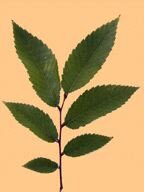
|
Leaves |
| . |
|
Leaf Anatomy |
| . |
|
Types of Leaves |
|
Broad-leaved plants are usually described as having simple or compoundleaves, while narrow-leaved evergreens have needle-like, awl-shaped, or scale-like leaves. The following are examples of different leaf types. |
| . |
 |
Simple: not divided into leaflets; leaf composed of one blade. |
| . |
 |
Compound: consists of two or more leaflets. |
| . |
 |
Pinnately Compound: feather-like; leaflets along each side of a common axis. |
| . |
 |
Bipinnately Compound: primary and secondary divisions are pinnate. |
| . |
 |
Palmately Compound: 3 or more leaflets radiating from a common point. |
| . |
 |
Trifoliate: three leaflets. |
| . |
 |
Fascicle: cluster of needles arising from one point. |
| . |
 |
Single Needle |
| . |
 |
Scale-like |
| . |
 |
Awl-shaped: tapering to a slender stiff point. |
| . |
|
Leaf Arrangement |
| . |
 |
Opposite: leaves are directly across from each other on the stem. Examples: Maple, Ash, Viburnum, Dogwood |
| . |
 |
Alternate: leaves are arranged singly at different heights and on different sides of the stem. Examples: Elm, Hackberry, Oak, Birch |
| . |
|
Leaf Shapes |
| . |
 |
Cordate: heart-shaped. |
| . |
 |
Elliptic: broadest in the middle and narrower at each end. |
| . |
 |
Flabellate: fan-like. |
| . |
 |
Lanceolate: longer than wide, broadest below the middle and tapering to the apex. |
| . |
 |
Obovate: inversely ovate, broadest above the middle. |
| . |
 |
Ovate: egg-shaped, broadest below the middle. |
| . |
 |
Broad Ovate: wide, egg-shaped. |

